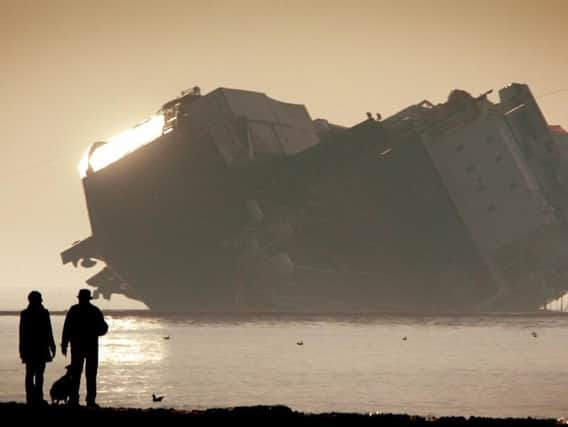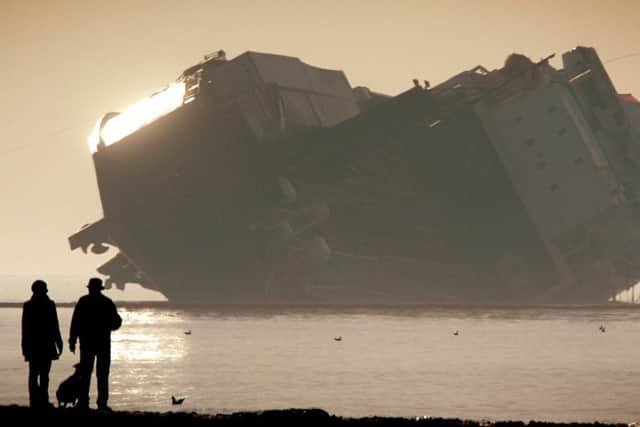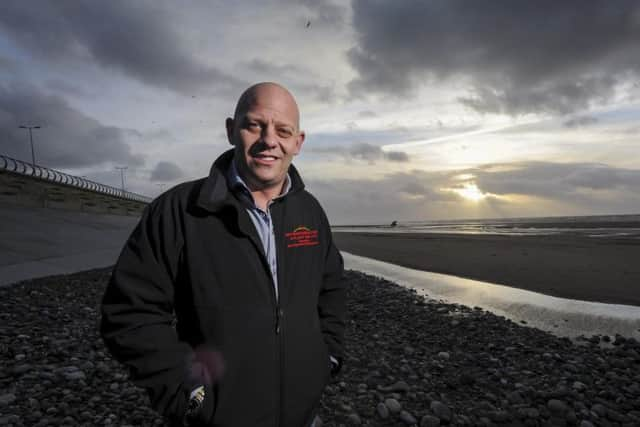RIVERDANCE DRAMA 10 YEARS ON: '˜No-one had ever done a salvage job like it before'


The accident, which left the ship stricken on the beach of Cleveleys for the best part of a year, and the major rescue mission which involved three helicopters, two lifeboats, and a small army of emergency workers on the shore, attracted significant media attention and around 100,000 tourists.
While it was bound for Heysham, its fate was ultimately sealed on the beach.
Advertisement
Hide AdAdvertisement
Hide AdAttempts to refloat it failed, meaning it had to be painstakingly taken down bit by bit.


Declared a ‘constructive loss’ after bad weather and shifting sands left it sinking deeper and deeper, almost bottom up and completely submerged at high tide, contractors planned to winch the ship before taking it on a final voyage to the scrapyard.
The final death knell sounded for the doomed ferry in early April, when it was finally confirmed it would be cut up on the beach.
Jim Hancock and his team from Lancaster were brought in, and studied the Riverdance’s sister ship, the Moondance, to come up with a plan.
Advertisement
Hide AdAdvertisement
Hide AdSpeaking after returning to the resort to speak to The Gazette, Jim said: “One of the biggest challenges, when we first got on there, was getting the oil off.


“We got designs and drawings of the boat and they were as big as my car. We had to have engineers to help us read them; we’re just demolition boys.
“There was supposed to be 150 tonnes of oil on there, and 300 tonnes later it was still coming off.
“The boat was lying on its side, and as the tide lifted it up and fetched it down, the boat was weakening.
Advertisement
Hide AdAdvertisement
Hide Ad“So the fear was the boat would crack, and if the boat cracked and the oil was on it...


“Nothing was damaged though. We did well.” He continued: “The boat was breaking. You could hear it groaning. Every day, [the site manager] John Horner stood at a certain post and took a picture of the boat at an angle. You could see it every day changing shape at the start.
“You could see it bending. As it was cracking, Smit Salvage were doing emergency repair work but it was all in vain.”
The recycling operation was expected to take 14 weeks, with the first four of five weeks spent gutting the ship, with 50 men sleeping in cabins on the Promenade.
Advertisement
Hide AdAdvertisement
Hide AdCargo - mostly wood, insulation, and scrap metal - was removed, as were any unnecessary parts, to reduce weight, stabilise the Riverdance, and make room.


The upper decks were then dismantled, with the hull the final section to be cut up, with each piece being removed from the beach by massive cranes.
During each stage of the process, anti-pollution measures were put in place to make sure there was no threat to life.
With the water lapping against the wreckage, crews had to work when the tide was out, including at night. It was also done slower than expected, after fuel was found to remain on board, and because of wind and rain.
Advertisement
Hide AdAdvertisement
Hide AdShortly before dawn on Saturday, May 17, 12 workers were evacuated after two tractor units burst into flames in the cargo hold, triggered by sparks showering down from cutting kit.
Fire crews were called out, but eventually withdraw to the safety of the prom to allow the rising tide to put the blaze out.
Firefighters later returned and, following an inspection, work continued and, by July, the ship’s heart, one of its huge 40 tonne engines, was removed and taken to a spares company in the north east.
The steel piece of the bow containing the ship’s name was kept by contractors as a memento of the operation, while the rest went to scrapyards, the main one being in Liverpool.
Advertisement
Hide AdAdvertisement
Hide AdAnd by mid-October, salvors were in the final stages of removing the stricken ship.
Sonar was used to check beneath the sand for any left-over metal, sparking unfounded rumours valuable cargo was lying around.
Mr Horner – who Jim said has since died – said a woman, with two children in a pram, crossed the beach at 11pm, in the ‘pitch black’.
He said: “She was looking for whisky.”A month later, the last pieces of Riverdance had been recovered from the sand, and the exclusion zone was lifted.
Advertisement
Hide AdAdvertisement
Hide AdThe government’s man in charge of the clear-up, Hugh Shaw, told The Gazette: “As far as we’re concerned the beach has now been cleared.”
Jim added: “It took an awful lot longer, but we had to do what we had to do. We had undertaken the challenge and we didn’t get paid for the job until we completed it.
“No-one had done a job like this, so it was a case of ‘suck it and see’. We got it done in the end, by hook or crook.”
The environmental damage caused by fuel and oil leaking from the Riverdance could have been catastrophic for marine life.
Advertisement
Hide AdAdvertisement
Hide AdBut contractors were praised for their efforts in keeping the beach oil and diesel free during the tricky operation, with fears of any spill going unrealised.
Michael Meekums from the Marine and Fisheries Agency said he was ‘very happy’ after no leaks were reported, while the Secretary of State’s Representative Huge Shaw - the man in overall charge of the ship’s removal - said he was ‘delighted’.
In recent years, the number of royal mammals - porpoises, whales, and bottlenose dolphins - washing ashore has risen, while basking sharks and humpback whales have been spotted swimming off the coast.
In 2016, a green turtle, usually only found in the Caribbean, was recorded by wildlife experts, while pods of dolphins are now routinely caught on tape by amazed holidaymakers.
‘I lost the love of my life because of Riverdance’
Advertisement
Hide AdAdvertisement
Hide AdDays after clearing the Riverdance off the beach, the boss of the firm brought in to complete the salvage job was ‘tortured’ by men looking for the cash.
Jim Hancock said men wearing balaclavas and wielding hammers and an axe battered him before ordering him to hand over the money from the multi-million pound job – which he said hadn’t even been paid out yet.
The 36-year-old, whose incredible story was backed up by police, said: “The curse of the Riverdance, that bit, yeah, it really was. There are some nasty people in the world. Jim said he was watching Coronation Street at the home he shared with his now ex-girlfriend when, half-asleep, he looked up to see a door open.
“There was a fellow there with a balaclava on and a sledgehammer in his hand,” he said. “I jumped up and got hold of the coffee table and flicked it. It hit him in the chin and he went down.
Advertisement
Hide AdAdvertisement
Hide AdThen another two lads just ran in, and that was the end of that for 40 minutes.”
The trio battered him and ordered him to hand over the cash he’d got for working on the ship.
“They thought we got paid in cash,” he said, blaming the attack on ‘bad information somewhere’.
He added: “Obviously they had seen the TV report that we had finished, and four or five days later came into my house.”
Advertisement
Hide AdAdvertisement
Hide AdJim said he discharged himself from the hospital, despite suffering broken bones, but said he had to stay in a safe house for two days. They never got any money out of me but that’s what came out of the job,” he added. “I lost my girlfriend as well that day. We split it because she couldn’t live back in that house. She was the love of my life. It scarred her for life. She moved to France to get away from it all. She couldn’t cope with it.
“Because they were never found, and the door was always locked at my house, life changed a little bit. I have never really had another girlfriend since. You know when you’ve something good in your life, that good, your soul-mate, and then you lose them, it’s hard work. It wasn’t a case of losing her from falling out of love, it was a case of she couldn’t bear to be there and I wouldn’t lose the house. It was my house and I wasn’t leaving because some idiots came in.”
Jim said he never reported the attack to police, but a force spokeswoman said officers opened an investigation after being called in by a neighbour.
She said they responded to reports of a robbery in Morecambe between 8pm and 8.20pm on Monday, November 10, 2008.
Advertisement
Hide AdAdvertisement
Hide AdRaiders beat a man, believed to be Jim, with their weapons before using cable ties to try and bubd his hands, crime logs showed.
A woman, understood to be his partner, was kicked in the head while Jim was forced upstairs to look for money.
They fled without any cash, but took a black Range Rover and two mobile phones – with nobody ever brought to justice for the crime.
Jim said: “One of my workers was in jail and he came out two or three years later. He said, ‘I was in the cells with a lad when I was at such-a-prison and he said he was the one who did the job on your house.’ He said he’d run a police man over afterwards, not that day but years on, and he got put inside for 25 years with no sign of early release, so karma does come back around.”